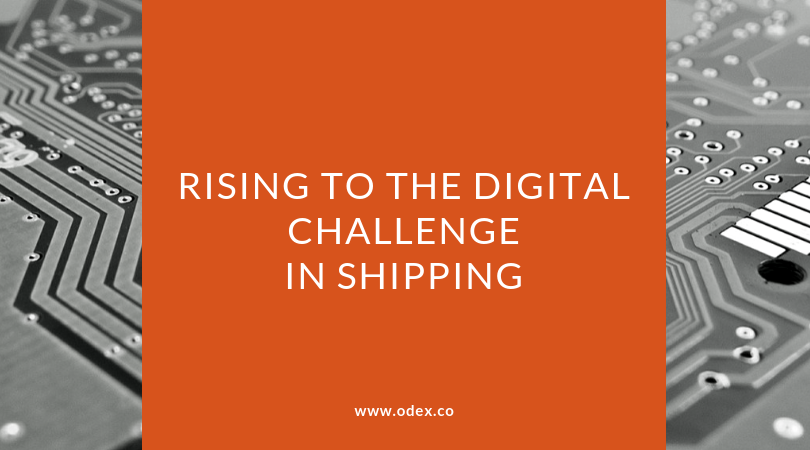Rising to the Digital Challenge in Shipping
In the coming 25 years, the container transport industry will go through a lot of significant changes as suggested by industry experts. It is being anticipated that the future scenario of the traditional supply chain service providers will be severely challenged. Since technology is steadily advancing with each day, it is no wonder that soon the digitally-enabled services will take over the maritime industry, as well.
These services will gradually influence the flow of goods from factories to consumers with its direct control system. Incidentally, the so-called ‘digital natives’ have the power to transform and rebuild the entire structure of the container transport industry. With the help of these ‘digital natives’, it is now possible to introduce the application of technology to a series of previously unsolvable challenges, just like in the case of e-commerce websites like Alibaba and Amazon.
Technology can also be applied in the case of “scrappy tech start-ups” and thus, fast-changing newcomers can act as crucial integrators. Recently, TT Club (a renowned international freight transport insurer) has joined hands with McKinsey (a global management consulting firm) to publish a report that will reflect on the future of the containerized trade. The report in question, called the ‘Brave New World? – Container Transport in 2043’, has thrown some light on the creation of value and the possible winners to declared within the industry by the year 2043.
The report contains some skillful observations regarding the perceptions of leading figures as concentrated on a cross-section of the transport scene in the marine industry. In fact, the report has stressed on the fact that an efficient containerized supply chain can go really big and affect the long-term results. This supply chain will be versatile enough to act like a conveyor belt from a factory to a consumer, with respect to the transportation of containers. The report also acknowledges the well-established paradox of cargo owners and end-consumers who happily habituated to lower prices. On the other hand, the remaining industry players undergo serious struggle and hardships to participate in the much-coveted value-creation.
According to information gathered by this particular report, the six potential sources of value creation are listed below:
- Greater Economies
In the recent times, there has been an extraordinary expansion in the vessel sizes that has caused a widespread impact on the rest of the container supply chain. A compulsory question has cropped up after this exceptional change in ship sizes, which contemplates the choices of the customers in the future. There is still a debate as to whether the customers will opt for more flexibility or reduced unit costs.
- Flexibility
A research is being conducted to determine whether the customers prefer direct and faster services. If the answer is positive, the scale will be deprioritized regarding the options of flexibility and modularity.
- Reliability and Predictability
We are all aware of how the e-commerce aspect changes the consumer expectations and which eventually leads to greater transparency and improved cycle-times in the supply chain.
- Consolidation and Integration
The factors of consolidation and integration in the maritime industry exist in a fragmented state as compared to the other industries. Honestly speaking, the potential of optimization through vertical integration can be observed in the selected segments of the industry.
- Automation and Productivity
Coming to the field of automation and productivity, these factors definitely possess the power to improve dependability and the service levels. Moreover, the structural costs are greatly lessened.
- Environmental Performance
Nowadays, every industry is concerned about protecting the ecological balance from the harmful effects of pollution. With the ever-growing societal sensitivity regarding the environmental protection, the challenges concerning emissions and fuels are being considered in a serious light.
The container transport sector is going through a huge transition as it is a phase involving an exceptional level of experimentation. There is a competitive spirit as different players are attempting to discover a winning formula that will successfully lead to value creation. As a consequence, the digital reinvention scenario is strictly applying the six potential sources of value creation.
Gradually, this will give rise to a suggested 2043 landscape wherein the incumbents belonging to the container transport sector pave the path for a digital future. As imagined, the digital future will not be driven by trade developments any longer. As a matter of fact, the shipping industry is entirely dependent on the driving factors of optimization, flexibility, and resilience.
The ‘last mile’ lessons are thoroughly applied to deep sea trades. In case you are wondering, the vertical integration becomes paramount in strategizing the construction of advanced digital platforms and operating systems, which further draw their benefits from an end-to-end demand in the supply chain. As the issues of deep integration and flexibility become more prominent in the customer supply chains, the scale economies slowly lose their significance. However, this will enhance the trustworthiness, transparency, and predictive capability of the supply chain in the future.


















